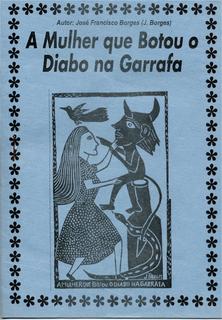Literatura do Cordel
 Particular to Northeastern Brazil is a form of popular literature called Literatura do Cordel or String Literature. Epic poems or songs written to inform as well as entertain the often -- at least historically -- illiterate inhabitants of the interior, Literatura do Cordel is so named due to the fact that the cheaply printed leaftlets are strung out to sell on string or twine [cordel in Portuguese]. Imported to Brazil by the Portuguese in the mid nineteenth century, Literatura do Cordel has its origins in medieval Europe and the age of the troubadours. Although the existence of similar forms of literature / communication in other parts of the world has mostly died out, the tradition continues in Northeastern Brazil and particularly in Pernambuco, home to some of the country's most eminent cordelistas.
Particular to Northeastern Brazil is a form of popular literature called Literatura do Cordel or String Literature. Epic poems or songs written to inform as well as entertain the often -- at least historically -- illiterate inhabitants of the interior, Literatura do Cordel is so named due to the fact that the cheaply printed leaftlets are strung out to sell on string or twine [cordel in Portuguese]. Imported to Brazil by the Portuguese in the mid nineteenth century, Literatura do Cordel has its origins in medieval Europe and the age of the troubadours. Although the existence of similar forms of literature / communication in other parts of the world has mostly died out, the tradition continues in Northeastern Brazil and particularly in Pernambuco, home to some of the country's most eminent cordelistas.The topics of the poems cover a wide range of subjects, from legends and myths to religious practices to football to news events of the day to awareness raising about political, social and health issues. Overall, thousands and thousands of titles exist and new ones are constantly being created. Titles range from The Woman who Put the Devil in a Bottle; Lambada in Hell; The Boy who Turned into a Goat in the State of Parana; The Romance of the Mysterious Peacock; The Visit of Satan to the Funk Rave; and The Marriage and Divorce of the Gecko to The Most Recent Apparition of Halley's Comet; The Fall of Saddam; Goodbye Princess Diana; Street Children and the Massacre at Candelaria; He who Sees Faces doesn't see AIDS; Strikes & Death in Volta Redona, RJ; and Agricultural Reform is a Right of all Brazilians.
 One of the notably features of Cordel Literature is the xylographies or woodprints that decorate the covers. Although the xylographies originally developed as an integral part of the cordel booklets, they eventually became an art form in their own right and can now be found on prints, tiles, mugs, shoulder bags, t-shirts, and even in commercial advertising.
One of the notably features of Cordel Literature is the xylographies or woodprints that decorate the covers. Although the xylographies originally developed as an integral part of the cordel booklets, they eventually became an art form in their own right and can now be found on prints, tiles, mugs, shoulder bags, t-shirts, and even in commercial advertising. Although Cordel is a phenomenon more closely linked to the interior, it can be found all over Recife in market stalls and being sold by perambulating vendors. There is even a pair of cordelistas who wander around Olinda making up songs and poems on the spot having to do with the actions of the people/audience around them. I'm even thinking that we should start producing some cordel to integrate into our outreach materials!


2 Comments:
Usually it is the same person, although I am not sure what happens when it is not since the leaflets cost a grand total of 50¢ each.
How cool is that?!
Post a Comment
<< Home